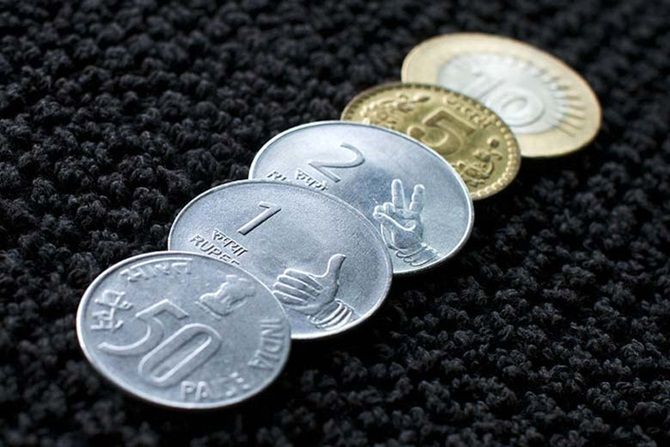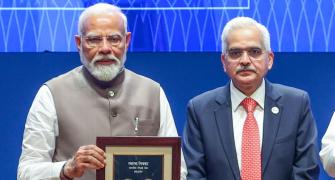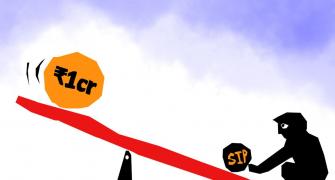Little attention is paid to the management of currencies and coins in India, where cash plays such a dominant role, says A K Bhattacharya.

India continues to be a predominantly cash economy. Look at it any way, cash is king in this country.
Cash in circulation as per cent of gross domestic product or GDP in India is over 12 per cent, compared to four per cent in Brazil, a little over five per cent in Mexico and four per cent in South Africa.
The amount of money held in currencies and coins relative to that held in demand deposits and savings accounts in banks is as high as 50 per cent, compared to five per cent for China and nine per cent each for Mexico and South Africa.
And in India, 87 per cent of all transactions are in cash, while in China it is much less at 62 per cent.
Yet, little attention is paid to the management of currencies and coins in India, where cash plays such a dominant role.
Two important institutions are involved in this key area - the directorate of currency under the ministry of finance and the Reserve Bank of India (RBI).
A lot of discussion takes place over how fiscal policy is to be implemented and how monetary policy must be used.
This is understandable. And, of course, all efforts should be made to dissuade people from using cash and encourage them to use cashless instruments like credit or debit cards, payment wallets, cheques, etc.
But there is no reason why more attention should not be paid to an area like the availability and supply of currencies and coins, which would no doubt make a big difference to most residents of this country.
First, take a look at the way the use of currencies and coins has evolved in the last three years.
In volume terms, the circulation of bank notes as per cent of all currencies in circulation has declined for all denominations except three - those for Rs 10, Rs 500 and Rs 1,000.
The trend is similar even in value terms. For coins in circulation, their volume share has declined for all denominations except three - those for Rs 2, Rs 5 and Rs 10.
Interestingly, coins circulation in value terms has seen a decline in their share for all denominations except only one - the 10-rupee coins.
This trend is not surprising, but should not be ignored either.
The use of bank notes and coins of higher denominations is seeing a sharper rise than those of lower denominations.
The overall volume growth of about eight per cent and 12-15 per cent in value last year over those in 2014-15 hides the larger story of how bank notes and coins of smaller denominations are becoming less popular.
However, the caveat here is that among bank notes, the sharp drop in the share of 100-rupee notes in total circulation is as significant as the rise in the share of 10-rupee notes.
These are trends that should certainly be useful inputs for both the RBI and the finance ministry, which should decide the adequate number of bank notes that should be made available within the system without any undue inconvenience to people.
While the Kolkata-headquartered Indian Statistical Institute may continue to undertake a study to refine the demand estimation model for bank notes and coins, these basic numbers show clear preferences for higher-denomination bank notes and coins, even as the use of 10-rupee notes continues to outpace that of bank notes with denominations of Rs 20, Rs 50 and even of Rs 100.
It must be acknowledged that the situation with regard to bank notes is fairly satisfactory.
Of course, the marked preference for denominations of Rs 10, Rs 500 and Rs 1,000 cannot be ignored.
The demands such a trend would make on the currency printing presses cannot be ignored. Indeed, the gap between the demands that are made on the four currency printing presses (two of them are run by an RBI subsidiary and the other two by a public sector undertaking under the finance ministry) and the supply is largely met, creating little stress.
However, the changing preferences for use of different denominations should be kept in mind.
The bigger problem is with regard to coins and this manifests more alarmingly in villages and smaller towns, instead of the bigger metropolitan cities.
Not many people in big cities bother about coins. But check out a small town or a village, the importance of coins of the right denomination would dawn on you instantly.
And the problem becomes evident when you realise that the annual supply shortfall in meeting the RBI’s demand for coins has consistently been ranging between 35 per cent and 43 per cent in the last three years.
The shortfall is not insignificant. All the mints that produce coins in India are operated by Security Printing and Minting Corporation of India Ltd (SPMCIL), a state-owned entity under the administrative control of the finance ministry.
So, how does the government meet the substantial demand-supply gap for coins? In recent years, coins have been imported to reduce the gap, but certainly it has not been eliminated.
There is a huge opportunity to produce more coins and improve the ease of living for ordinary residents in India, particularly in villages and small towns.
But if you take a look at the annual reports of the finance ministry and SPMCIL, you will sense how both the agencies are congratulating themselves on how well they have done by producing more coins and increasing the productivity of their employees.
There is no mention of the huge demand-supply gap in coins that is brought out by the latest annual report of the RBI.
It is time the government recognised the reality, abandoned the easy path of imports to meet the shortfall and instead stepped up domestic capacity and productivity to produce more coins in its existing mints.
The government’s four mints can also help achieve the goals of Make in India!








